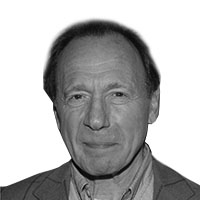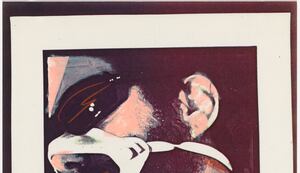As COVID-19’s grip on New York slackened, art events began popping up as insistently as an artist sticking slides in your face. Some are lodged in my memory, like the May show at Kaatsbaan, a cultural center on a former Roosevelt-frequented horse farm in Tivoli, with a barn designed by Stanford White.
This was curated by Hilary Greene and Jen Dragon and was mostly sculptural, including Millicent Young’s horsehair and grapevine suspended installations, Gregory Steel’s Minimalist piece and three carved stone pieces by Kenichi Hiratsuka, one of whose larger works numbers of New Yorkers regularly walk on—the intricate 100 foot long and 16 foot wide piece incised in the sidewalk at 25 Bond Street in Manhattan.
A couple of screenings signaled that the art world in Manhattan was champing at the bit too.
On May 23, Gerard Malanga, a key early associate of Andy Warhol, presented a book, The New Melancholia & Other Poems, and an outdoor screening at the Elizabeth Street Garden, a community garden between Prince and Spring, of his 1967 film, In Search of the Miraculous. Pure time travel this, a bit shadowed by hearing that the remarkable garden is under threat and that Alan Midgette, famous for presenting himself as a fake Warhol at college events way back, had just died in Woodstock.
Amongst those spotted in the substantial crowd were Dagon James, who will be publishing Gerard Malanga’s Secret Cinema, and the legendary Danny Fields, flat-mate of Edie Sedgwick and discoverer of the Ramones, whom he took to the UK, where they helped to kickstart punk rock.
And the second screening? That was Beth B’s docu about the in-your-face performance artist, Lydia Lunch: The War is Never Over. This was hardcore, excellent. Later that evening some of us dashed on to where Blake Sandberg, the Texas-born Brooklyn painter, was performing with his rock band, Aliens, at the re-opening of the Downtown hot spot, Bowery Electric. Yes, the joints again are jumping.
Nadine Johnson’s event for ZHA Close Up, the show of work by the late great architect, Zaha Hadid, now up at MAM, Shanghai’s Museum of Modern Art, was held in the extraordinary space at 528 East 28th Street, Hadid’s only building in New York. It was quite a crowd. Faces floating around included Tony Shafrazi and Conrad de Kwiatkowski, artist son of Henryk, the late legendary financier, gambler and horse breeder, and folk from MAM, including Heiko Stober and Shai Baitel, the artistic director.
Nejma Beard has been keeping her head down in Montauk, working on the late great Peter Beard’s estate, specifically helping the gallerist, Pilar Ordovas, put together a focused show. “It’s called Wild Life and it’s about the friendship between Francis Bacon and Peter Beard, a friendship that began when they met in the mid ’60s,” Ordovas told me. “It was incredibly deep. Peter did a series of works in 1972 which he sent to Bacon and he took photographs of him in his studio. Bacon allowed him to take photographs of works in progress, something that he didn’t really allow anyone to do. The show, which is now in Ordovas’ gallery in London, will be in her New York gallery next spring.
New York galleries are opening spaces state-wide; the Fridman Gallery, for instance in just opened in Beacon, NY. Why Beacon? “It’s a culture hub,” Ilya Fridman said. “There’s Dia Beacon, of course. But also it’s a complete mental break from the hustle and bustle of the city. There’s a post-Covid feel to the place. It’s more contemplative.”
Contemplative may not be quite the word for what is going on in the Hamptons. A local law passed in Southampton last year stipulates that vacant storefronts in Southampton Village should put artworks in their windows to cheer things up. This law—an excellent idea for the Death Valley stretches on Bleecker Street, by the way—would seem unnecessary in East Hampton, which has been busting out with art all over.
Chase Contemporary, who had a pop-up in Montauk last summer, opened an East Hampton space at 66 Newtown Lane last weekend with an ultra-Manhattan show, Shadowman, dark figure paintings by the late Richard Hambleton, like those he would paint on ruinous walls in the East Village. “East Hampton has a concentration of wealth and art collectors,” says Isabel Sullivan of Chase. “It’s been amazing.”
Chase are next to the East Hampton location for New York’s Skarstedt Gallery, which has an all-Warhol show including a remarkable early self-portrait, and on the other side of Skarstedt was another familiar name, Sotheby’s. Well, the auction house has been running a public gallery for private sales in Manhattan for several years now but it has been part of their main building on York. The space in East Hampton is elegantly disconcerting in that it is purely a gallery, and choc-a-bloc with Minimalist pieces by Dan Flavin, Sol LeWitt and Donald Judd.
Near at hand also was Christophe van de Weghe, who spearheaded the influx from the city when he opened an East Hampton space in April 2020. Van de Weghe, who has two spaces on Madison Avenue, on 76th and 78th, and will shortly be opening on 521 West 23rd, has done himself proud in East Hampton, bringing 14 Basquiats, seven paintings and seven drawings. “He has the hottest market of any artist in the world,” Van de Weghe said.
So lively indeed is the East Hampton gallery district, with an active foot traffic which is way more likely to be potential buyers than gawkers, that it seems natural to wonder whether this represents a durable development, just as we wonder to what extent working remotely will remain widespread, post-pandemic.
The larger question remains an unknown but in East Hampton you can at least ask. “We have a long-term lease on that space,” says Christopher Pusey from Chase Contemporary. ”It just makes sense for us. A lot of our clients are here”.
“I haven’t decided,” said the San Francisco gallerist, Jon Berggruen. “London, Palm Beach,” he said. “I don’t actually know what we’re going to do.”
Christophe Van De Weghe does. “I’m staying. I like it here,” he says. Kind of promising, no?
So back to the city where Marlborough had a dual opening on Wednesday, Wild at Heart on their ground floor at 425 West 25th and A Day At The Beach on the first. It was a lively opening. Artists showing their faces included Alice Aycock, Ron Ortner and Ivana Basic, a Serb, creator of compelling melty ceramics, one of which is seemingly unleashing a Munchian scream. Linda Obuchoska, the art photographer—who arrived with the cinematographer Mark Brady as I was leaving—told me that that this was only the second opening she has been to since the virus bit. Two young women I spoke to separately, Courtney King, a product designer, and Jane Kay, a graphic artist, told me it had been their first.
On Thursday evening, R!SE, a show of the work of the photographer, Layla Love, organized by a London-based gallerist, Bailey Lalonde, Director of the Freeman Foundation, opened in the private space of BINDER Foundation. It was a benefit for Rise of the Butterfly, Layla Love’s anti-trafficking movement, containing the work of twenty other artists and—disclosure time—I am a co-curator. Ray Angry, who was playing with JoDN and Jerome David Sloss, normally plays at another re-opened LES hotspot, Nublu.
On Friday there were two poetry readings in galleries, one in Lichtundfire on Rivington, the other at the 292 Theatre Gallery on East 3rd Street, where there was a dual opening of work by Charlie Schick and Regina Bartkoff. Among those present were the painter Rick Prol and Jane Friedman, mainstay of one of the city’s liveliest exhibition and event spaces, Howl! Happening. Yes, for sure the New York art world is back and bouncing.







